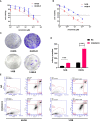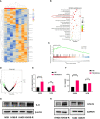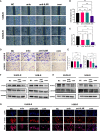Tocilizumab (monoclonal anti-IL-6R antibody) reverses anlotinib resistance in osteosarcoma
- PMID: 37404767
- PMCID: PMC10315670
- DOI: 10.3389/fonc.2023.1192472
Tocilizumab (monoclonal anti-IL-6R antibody) reverses anlotinib resistance in osteosarcoma
Abstract
Purpose: Anlotinib, a tyrosine kinase inhibitor (TKI) has been in clinical application to inhibit malignant cell growth and lung metastasis in osteosarcoma (OS). However, a variety of drug resistance phenomena have been observed in the treatment. We aim to explore the new target to reverse anlotinib resistance in OS.
Materials and methods: In this study, we established four OS anlotinib-resistant cell lines, and RNA-sequence was performed to evaluate differentially expressed genes. We verified the results of RNA-sequence by PCR, western blot and ELISA assay. We further explored the effects of tocilizumab (anti- IL-6 receptor), either alone or in combined with anlotinib, on the inhibition of anlotinib-resistant OS cells malignant viability by CCK8, EDU, colony formation, apoptosis, transwell, wound healing, Cytoskeletal stain assays, and xenograft nude mouse model. The expression of IL-6 in 104 osteosarcoma samples was tested by IHC.
Results: We found IL-6 and its downstream pathway STAT3 were activated in anlotinib-resistant osteosarcoma. Tocilizumab impaired the tumor progression of anlotinib-resistant OS cells, and combined treatment with anlotinib augmented these effects by inhibiting STAT3 expressions. IL-6 was highly expressed in patients with OS and correlated with poor prognosis.
Conclusion: Tocilizumab could reverse anlotinib resistance in OS by IL-6/STAT3 pathway and the combination treatment with anlotinib rationalized further studies and clinical treatment of OS.
Keywords: anlotinib; drug resistance; interleukin-6; osteosarcoma; tyrosine kinase inhibitor.
Copyright © 2023 Xu, Chen, Sun, Shi, Wang, Huang, Ren and Tang.
Conflict of interest statement
The authors declare that the research was conducted in the absence of any commercial or financial relationships that could be construed as a potential conflict of interest.
Figures






Similar articles
-
PI3K inhibitor impairs tumor progression and enhances sensitivity to anlotinib in anlotinib-resistant osteosarcoma.Cancer Lett. 2022 Jun 28;536:215660. doi: 10.1016/j.canlet.2022.215660. Epub 2022 Mar 19. Cancer Lett. 2022. PMID: 35318116
-
BMS-794833 reduces anlotinib resistance in osteosarcoma by targeting the VEGFR/Ras/CDK2 pathway.J Bone Oncol. 2024 Mar 16;45:100594. doi: 10.1016/j.jbo.2024.100594. eCollection 2024 Apr. J Bone Oncol. 2024. PMID: 38532893 Free PMC article.
-
Autophagy inhibition potentiates the anti-angiogenic property of multikinase inhibitor anlotinib through JAK2/STAT3/VEGFA signaling in non-small cell lung cancer cells.J Exp Clin Cancer Res. 2019 Feb 12;38(1):71. doi: 10.1186/s13046-019-1093-3. J Exp Clin Cancer Res. 2019. PMID: 30755242 Free PMC article.
-
Effective treatment of anlotinib in giant delayed pulmonary metastasis of osteosarcoma: a case report and literature review.Ann Palliat Med. 2021 Jun;10(6):7073-7082. doi: 10.21037/apm-20-1790. Epub 2021 Jan 29. Ann Palliat Med. 2021. PMID: 33548989 Review.
-
Interleukin-6 induces drug resistance in renal cell carcinoma.Fukushima J Med Sci. 2018 Dec 8;64(3):103-110. doi: 10.5387/fms.2018-15. Epub 2018 Oct 23. Fukushima J Med Sci. 2018. PMID: 30369518 Free PMC article. Review.
Cited by
-
Enzymatic TET-1 inhibition highlights different epigenetic behaviours of IL-1β and TNFα in tumour progression of OS cell lines.Clin Epigenetics. 2024 Oct 2;16(1):136. doi: 10.1186/s13148-024-01745-4. Clin Epigenetics. 2024. PMID: 39358792 Free PMC article.
-
N6-Methyladenosine modification mediated by METTL3 promotes DNA-PKcs expression to induce anlotinib resistance in osteosarcoma.Clin Transl Med. 2025 Feb;15(2):e70228. doi: 10.1002/ctm2.70228. Clin Transl Med. 2025. PMID: 39924638 Free PMC article.
References
LinkOut - more resources
Full Text Sources
Miscellaneous

